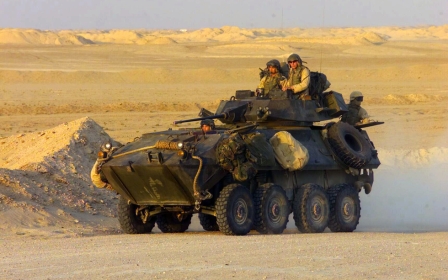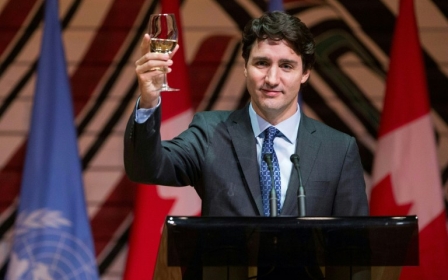European vote on Saudi arms embargo puts heat on Canada

TORONTO, Canada - A European Parliament vote to impose an arms embargo on Saudi Arabia has increased the pressure on Canada to review its own, multi-billion-dollar weapons deal with the Gulf power.
The vote comes as serious questions are being raised in Ottawa over mounting evidence that Canadian-made weapons are being used by parties fighting in the war in Yemen.
Canadian media reported last week that Canadian-made rifles had fallen into the hands of Houthi rebel fighters in Yemen, probably after being seized by Saudi forces. Images shared online also showed the Saudis reportedly using Canadian-made, light-armoured vehicles (LAV) inside Yemen and on the Saudi-Yemen border.
These revelations “increase the pressure on the Canadian government to explain why it continues to move forward with a LAV deal” worth $15bn, between a Canadian company and Saudi Arabia, said Hilary Homes, an Amnesty International Canada campaigner.
Nearly half of all Canadians (48 percent) say the government has made a "bad decision" in standing by the Saudi arms deal, a new Angus Reid Institute poll found. A majority of Canadians (54 percent) also say they are most inclined to condemn Saudi Arabia, compared to 10 percent who say they respect the kingdom and 36 percent that are unsure.
Signed in 2014, the landmark arms agreement – the largest in Canadian history – will see Ontario-based General Dynamics Land Systems send hundreds, if not thousands, of militarised LAVs to Riyadh. Shipments may begin later this year.
“What’s interesting about this is that nobody is admitting whose weapons they are,” Homes told Middle East Eye, about the weapons that have turned up in Yemen. “One of the reasons for that silence may be that there is then a responsibility.
“If you admit it’s yours, there are obligations that go with that.”
Weapons used in Yemen
What looks to be an abandoned Canadian-made LAV appears in a Youtube video dated 3 December, allegedly deserted during border clashes between the Houthis and Saudi forces. Middle East Eye could not independently verify the contents of the video.
The Globe and Mail also first reported that Canadian-made LAVs were photographed on their way to Najran, near the Yemeni border. Saudi Arabia’s National Guard, the recipient of Canadian arms exports dating back decades, shared those images on its official Twitter feed.
“A significant number of vehicles in the photos have the triangular front corners, the eight wheels and the headlamps fixed above these triangles that are familiar features in earlier LAV models made in Canada,” the newspaper reported.
National public broadcaster CBC also reported that a photo posted on Twitter showed a Houthi fighter holding a rifle that was allegedly manufactured by a Winnipeg-based company, PGW Defence Technologies Inc.
“There seems to be more than one kind of PGW weapon in the hands of the Houthi rebels,” said Ken Epps, a policy advisor for the anti-war group Project Ploughshares, which tracks arms sales. Epps said the assumption is that the PGW weapons were seized from Saudi forces in Yemen.
The company, which Epps said was previously known as Prairie Gun Works, lists the Royal Saudi Land Force and the UAE Armed Forces among its clients. PGW did not respond to Middle East Eye’s request for comment.
Company owner Ross Spagrud told CBC: “All our exports are undertaken via the authority of export permits which are issued by the government of Canada.”
“We know that Canada has been providing military goods to basically all the members of the coalition that Saudi Arabia is leading (in Yemen), including the United Arab Emirates, Oman, Kuwait, Bahrain and others,” Epps told Middle East Eye.
“It would seem that it’s just a matter of time before more evidence emerges that Canadian equipment is involved.”
No comment from Ottawa
A spokesperson for Global Affairs Canada told Middle East Eye the government had no comment about allegations that Canadian weapons are in Yemen.
“Canada already has some of the strongest export controls in the world through the Export and Import Permits Act,” spokesperson Francois Lasalle wrote in an email.
“Export licenses are only approved if they are compatible with Canadian foreign policies, including with regards to human rights,” he said.
Lasalle also reiterated the Liberals’ position that they will not review the Saudi arms deal.
In the House of Commons last week, Liberal MP David Lametti, secretary to the minister of international trade, said the government takes the possibility of Canadian weapons being in Yemen “very seriously”.
“Yesterday, the minister asked the department for more information on an investigation into the matter. During the election campaign, we promised that we would be more transparent and more accountable on this kind of issue and that is exactly what we are going to do,” Lametti said, without providing further details.
Lametti also did not respond to two direct questions from MP Helene Laverdiere, a member of the left-leaning New Democratic Party (NDP), who asked whether the government could confirm that Canadian weapons were in fact being used in Yemen.
Weapon imports facilitate Yemen war
From 2011-2015, Saudi Arabia received 27 percent of all arms transfers to the Middle East, making it the second largest arms importer in the world, according to the Stockholm International Peace Research Institute (SIPRI). Saudi arms imports have increased by 275 percent in that time compared to 2006-2010, SIPRI also found.
The kingdom is expecting more weapons soon, including 150 combat aircraft and thousands of air-to-surface and anti-tank missiles from the US, 14 combat aircraft from the UK, and a “large number” of armoured vehicles from Canada included in the $15bn deal.
Pieter Wezeman, a SIPRI senior researcher on arms and military expenditures, said the countries that make up the Saudi-led coalition in Yemen are “primarily dependent on arms imports,” which have facilitated their involvement in the war.
“They have very limited arms industries themselves so whatever they use they will have to get from elsewhere,” Wezeman told Middle East Eye.
Wezeman said he couldn’t confirm the veracity of reports that Canadian LAVs are in Yemen already, but he said their use in the conflict would not be surprising.
“They are being used in the kind of conflicts which you see in Yemen, so the chances that they would turn up there at a certain point are still quite high.”
The US remains Canada’s largest export market for military equipment. But excluding the US, Saudi Arabia accounted for 33 percent of all Canadian military exports in 2012 and 2013 and received a total of $575.1mn worth of goods. Canada has exported light-armoured vehicles to Saudi Arabia since the early 1990s.
The United Arab Emirates was the second-largest destination for Canadian arms exports (again, excluding the US) with $281.1mn total sales in 2012 and 2013.
Canadian export controls
Under federal export laws, Ottawa must conduct a human rights review for any country with “a persistent record of serious violations of the human rights of their citizens” that seeks to buy Canadian-made military equipment.
Those regulations force Canada to show that “no reasonable risk” exists for the goods to be used against civilians, and oblige Canada to monitor exports “involved in or under threat of hostilities”.
Saudi Arabia is an Arab coalition of countries involved in air strikes and ground battles against Houthi rebel fighters in Yemen. More than 6,000 people, including many civilians, have been killed since the start of the operation in March 2015.
A UN panel of experts found “widespread and systematic” use of air strikes and shelling by members of the coalition, including air strikes targeting camps for internally displaced persons and refugees, weddings, buses, medical facilities, schools, mosques, markets, factories and food storage warehouses.
“The panel documented 119 coalition sorties relating to violations of international humanitarian law,” the report reads.
In October, Amnesty International called for a halt to transfers “of weapons and munitions which have been used to commit violations of international humanitarian law, including war crimes in Yemen”.
Homes said the worsening conflict in Yemen raises serious questions about how Canada monitors its arms exports. “Regardless of the original intention, is this a situation where you can maintain control? It’s why we become even more concerned with (weapons) transfers when conflict breaks out,” she said.
“This is a government that is priding itself on a desire to be transparent and the great irony here is that … we’re not seeing a lot of transparency here.”
New MEE newsletter: Jerusalem Dispatch
Sign up to get the latest insights and analysis on Israel-Palestine, alongside Turkey Unpacked and other MEE newsletters
Middle East Eye delivers independent and unrivalled coverage and analysis of the Middle East, North Africa and beyond. To learn more about republishing this content and the associated fees, please fill out this form. More about MEE can be found here.




